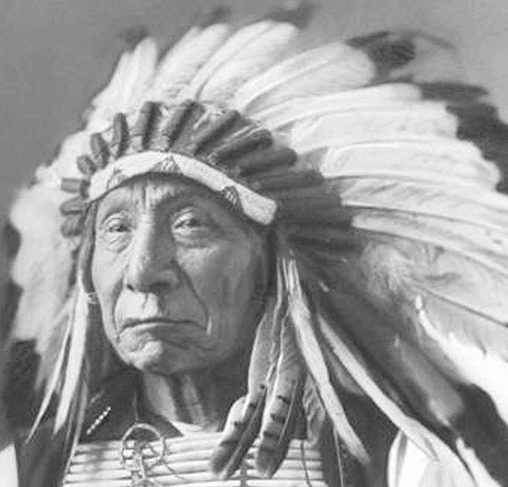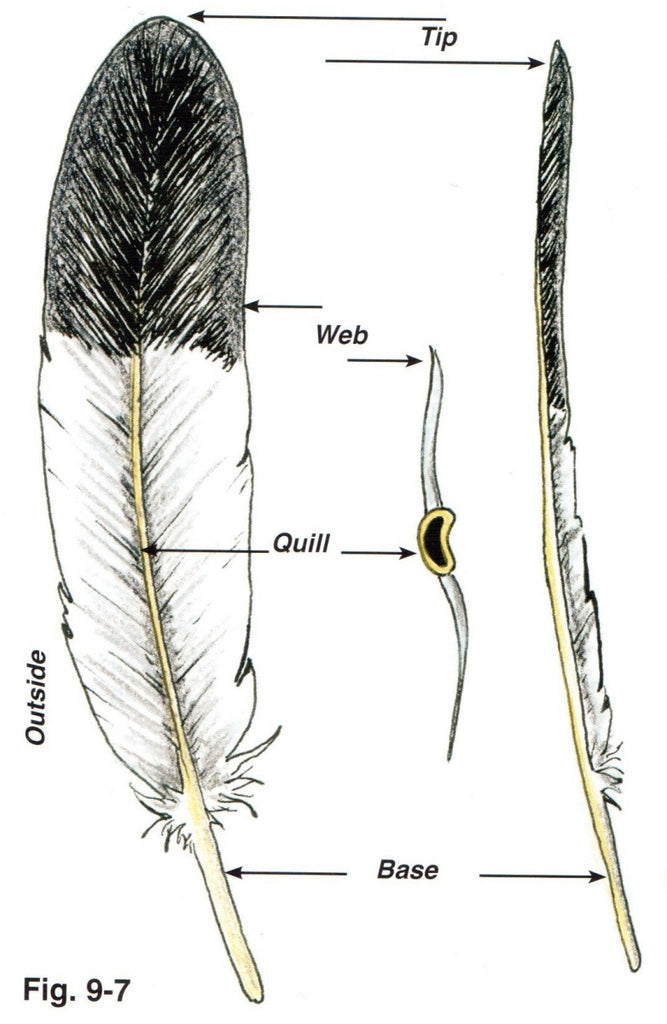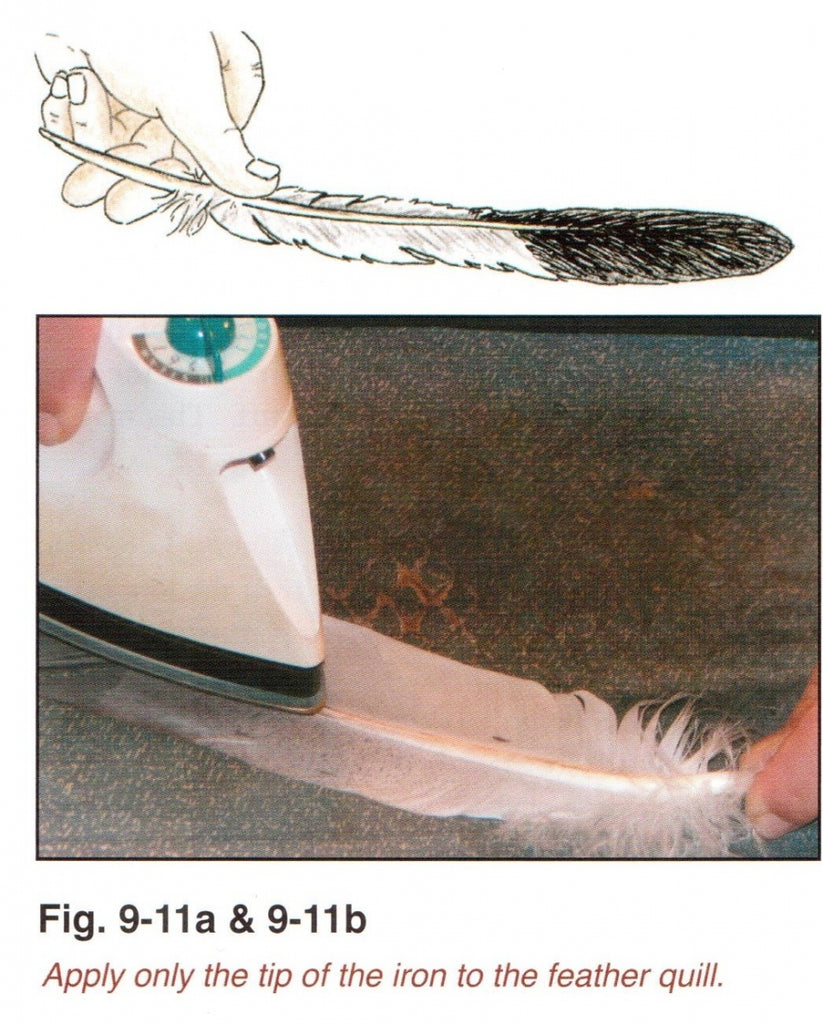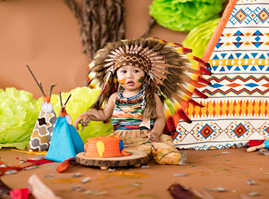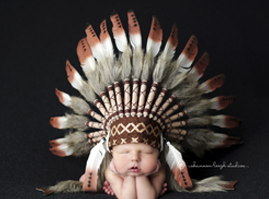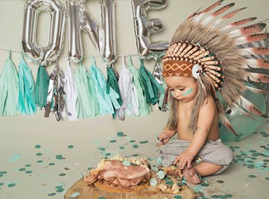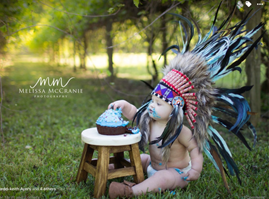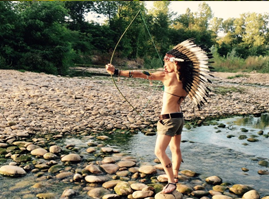2 - Crown -
2 - Crown -
HOW TO MAKE A NATIVE INDIAN HEADDRESS / WARBONNET ? -
Crown: Leather Crown (Fig. 9-1) Making a crown begins by first measuring the circumference of your head with a cloth tape measure.
How you choose to wear your bonnet (either pulled forward or pulled back) will contribute to how the bonnet feathers fall. Once this decision is made, measure around your head from just above the eyebrows, across the horizontal ridge of bone across the bottom back of your skull just above the neck, and back to the front. The crown should be a little loose and may even cover the tops of your ears, so add enough to your measurement to accommodate this. A good place to start is so that two fingers can fit easily under the circumference measurement. You may also find it helpful in constructing the crown to know the measurement across the head from ear to ear (remembering that you may want the crown to overlap the ears). For the Swept Back style, the back section must be longer by 1” than the sides or front. Plan accordingly if you make your own bonnet crown. For example, if you use an old hat, the back of the crown should extend 1” onto the brim in a graceful curve (Fig. 9-2a).
A two piece crown will have the seam running down the center of the head, from front to back. A three piece crown consists of a rectangular center strip about 3” wide that runs front to back, on each side of which are sewn two symmetrical half-circles. This is a good crown style for making a bonnet. In this case, the two side pieces will not be symmetrical but will have the back ends elongated compared to the front half of each “semi-circle”. A four piece crown has 4 pie shaped pieces sewn together. (fig.9-2b,c, & d) 

 Once you are satisfied with the fit of you pattern, take it apart and transfer the shapes to leather for the crown by outlining each piece with pencil (not ink). (Note: it is ALWAYS best to pre-stretch leather before you make any kind of garment article from it. Soak the hide in water, then stretch it as tight as possible while tacking it to a board. When dry, soften the leather by rubbing it between your hands.) Warning: Crowns made from unstretched leather are likely to become misshapen over time, resulting in a poor-fitting warbonnet. Cut out the pieces, and then sew them together with a not-too-snug whipstitch. Note: If you pull the stitches tight, you will end up with ridges along the seams. When sewn with just a little bit of slack, the seams can be pressed flat when you are finished. Felt Crown: If you are using a manufactured felt crown or old felt hat, it probably will need to be trimmed to the proper length and then sized by reducing the circumference to fit your head. For an old hat, remove the inside liner and outside sweat band, then cut off the brim, but if are making a Swept Back bonnet, only cut off the front 2/3rds of the brim (from behind the ears on one side, all round to behind the ears on the other). You will need a portion of the back for the crown extension discussed earlier. (Fig. 9-2a) A cloth pattern (see above) can be helpful to cut and re-size pre-fabricated crowns. Place the pattern inside the crown and use chalk to mark the crown where it needs to be cut. If you choose not to use a pattern, first try on the crown (hat) to see how it fits. It will need to be marked and cut in 2 steps to (a) establish the circumference and, (b) reduce the circumference. First, have a friend mark the crown around the circumference where it will need to be trimmed for length (i.e., Decide whether you want a two, three, or four piece cap, then take your circumference measurement, divide it by the number of pieces in the crown (if 2 or 4 pieces), and plot out a paper pattern for each of the parts. (For 3 piece crown with 3” center strip, subtract 6” from the head circumference and divide by 2: this will give you the bottom dimension for each of the two side pieces.) Then use these patterns to cut identical pieces from scrap cloth (anything that has some thickness but is non-stretchy will do, like felt or blanket scraps). Staple the pieces together with flat seams, try on the resulting skull cap, then adjust your pattern accordingly. How far down on your head it fits). Note that, when the crown is laid flat with the front center on top, you will probably be cutting the crown in a curved line. (Fig. 9-3)
Once you are satisfied with the fit of you pattern, take it apart and transfer the shapes to leather for the crown by outlining each piece with pencil (not ink). (Note: it is ALWAYS best to pre-stretch leather before you make any kind of garment article from it. Soak the hide in water, then stretch it as tight as possible while tacking it to a board. When dry, soften the leather by rubbing it between your hands.) Warning: Crowns made from unstretched leather are likely to become misshapen over time, resulting in a poor-fitting warbonnet. Cut out the pieces, and then sew them together with a not-too-snug whipstitch. Note: If you pull the stitches tight, you will end up with ridges along the seams. When sewn with just a little bit of slack, the seams can be pressed flat when you are finished. Felt Crown: If you are using a manufactured felt crown or old felt hat, it probably will need to be trimmed to the proper length and then sized by reducing the circumference to fit your head. For an old hat, remove the inside liner and outside sweat band, then cut off the brim, but if are making a Swept Back bonnet, only cut off the front 2/3rds of the brim (from behind the ears on one side, all round to behind the ears on the other). You will need a portion of the back for the crown extension discussed earlier. (Fig. 9-2a) A cloth pattern (see above) can be helpful to cut and re-size pre-fabricated crowns. Place the pattern inside the crown and use chalk to mark the crown where it needs to be cut. If you choose not to use a pattern, first try on the crown (hat) to see how it fits. It will need to be marked and cut in 2 steps to (a) establish the circumference and, (b) reduce the circumference. First, have a friend mark the crown around the circumference where it will need to be trimmed for length (i.e., Decide whether you want a two, three, or four piece cap, then take your circumference measurement, divide it by the number of pieces in the crown (if 2 or 4 pieces), and plot out a paper pattern for each of the parts. (For 3 piece crown with 3” center strip, subtract 6” from the head circumference and divide by 2: this will give you the bottom dimension for each of the two side pieces.) Then use these patterns to cut identical pieces from scrap cloth (anything that has some thickness but is non-stretchy will do, like felt or blanket scraps). Staple the pieces together with flat seams, try on the resulting skull cap, then adjust your pattern accordingly. How far down on your head it fits). Note that, when the crown is laid flat with the front center on top, you will probably be cutting the crown in a curved line. (Fig. 9-3)  This will result in a crown that appears even all around when worn. Cut along this line. Now, put the crown back on and, if it is too large in circumference, trim and sew as per Fig. 9-4a through c. Remember that the crown should be a little loose, and you should be able to place 1-2 fingers under the crown edge.
This will result in a crown that appears even all around when worn. Cut along this line. Now, put the crown back on and, if it is too large in circumference, trim and sew as per Fig. 9-4a through c. Remember that the crown should be a little loose, and you should be able to place 1-2 fingers under the crown edge. 

 The crown for a Swept Back Bonnet needs to retain a 1” extension of material onto the back brim like a very small duck bill, so include this consideration in your measurements and cutting. -
The crown for a Swept Back Bonnet needs to retain a 1” extension of material onto the back brim like a very small duck bill, so include this consideration in your measurements and cutting. -

